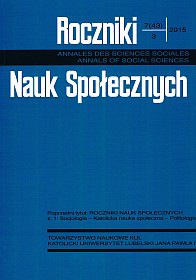Specificity of contemporary Central Asian regionalism
Abstrakt
Specyfika regionalizmu Azji Środkowej
W celu udzielenia odpowiedzi na pytania badawcze dotyczące procesu regionalizacji bezpieczeństwa w Azji Środkowej, niezbędne jest rozważenie kwestii bezpieczeństwa w kontekście regionalnym jako zespołu idei, norm, instytucji i tożsamości, które są tworzone przez państwa. Moje podstawowe pytanie badawcze jest następujące: jaka jest obecnie dynamika oraz jakie są podstawy środkowoazjatyckiego regionalizmu. Dlatego celem mojego artykułu jest zaprezentowanie obecnej specyfiki regionalizmu Azji Środkowej. Koncentruję się także na konstruktywistycznych rolach społecznych i kulturalnych kwestii oraz na wkładzie Kazachstanu w rozwój regionalizacji bezpieczeństwa w Azji Środkowej. Te aspekty są ważne, by zrozumieć obecną ewolucję regionalizmu w regionie Azji Środkowej.
W pierwszej części zdecydowałem się przedstawić istotne koncepcje regionalizmu i regionalizacji, które stanowią dla mnie kluczową podstawę umożliwiającą analizę znaczenia podejścia regionalnego na poziomie krajów Azji Środkowej. Następnie skupiam się na trendach i podstawach regionalizacji w Azji Środkowej, kazachskiej roli w tym procesie, zaś wszystkie moje wnioski i odpowiedzi na postawione pytania zwieńczone zostały sekcją poświęconą konkluzjom.
Bibliografia
Akiner S., Melting Pot, Salad Bowl – Cauldron? Manipulation and Mobilization of Ethnic and Religious Identities in Central Asia, “Ethnic and Racial Studies”, Vol. 20, No. 2, 1997.
Allison R., Regionalism, Regional Structures and Security Management in Central Asia, “Royal Institute of International Affairs”, 80:3, May 2004.
Avioutskii V., Aksamitne rewolucje, Warsaw: Dialog, 2007.
Baluk W. i Czajowski A. (eds.), Ustroje polityczne krajów Wspólnoty Niepodległych Państw, Wrocław: Wydawnictwo Uniwersytetu Wrocławskiego 2007.
Blank S., The United States and Central Asia, Central Asian Security: The New International Context, [in:] R. Allison, L. Jonson (eds.), The Royal Institute of International Affairs, London, Brookings Institution Press 2001.
Bohr A., Central Asia: responding to the multi–vectoring game, Chatham House, 22.02.2010.
Bohr A., Regionalism in Central Asia: New Geopolitics, Old Regional Order, “International Affairs”, Vol. 80, No. 3, 2003.
Bohr A., Revolution in Kyrgyzstan – Again, Programme Paper 03/10, Chatham House, 2010.
Brenneman R., WikiCable: Kazakhstan as a Pentagon satellite, 09.01.2011, Wordpress.com.
Büyükakıncı E., Patterns of Integration in Central Asia, Department of International Relations, Galatasaray University, İstanbul, 2012.
Buzan B., Wæver O., de Wilde J., Security: a new framework for analysis, Boulder, CO: Lynne Rienner Publishers 1998.
Chung E., Multiple Regional Security Frameworks for Central Asia, “Austrian Institute for International Affairs”, 27.11.2006.
Dadabaev T., Central Asian regional integration: between reality and myth, Central Asia-Caucasus Analyst, Vol. 9, No. 9, Washington, 18.04.2007.
Falk R.A., The Declining World Order America’s Imperial Geopolitics, New York– London: Routledge 2004.
Fitzgerald E., Vira V., U.S. and Iranian Strategic Competition: Competition in Afghanistan, Central Asia, and Pakistan, “Center for Strategic & International Studies”, 12.09.2011.
Freedom in the World Index, Freedom in the World 2013, Freedom House, 2013.
Gleason G., Prospects for Kazakhstan’s Asian Liberalism, “Demokratizatsiya”, 5, No. 3, 1997.
Hettne B., Inotai A., Sunkel O., The New Regionalism Series, (Vol. 1-5), London: Macmillan 1999-2001.
Hurrell A., Regionalism in theoretical perspective: regional organization and international world order, [in:] L. Fawcett, A. Hurrell (eds.), Regionalism in World Politics, Oxford: Oxford University Press 1997.
Jarosiewicz A., Rozmowy wokół kryzysu nuklearnego w Ałmaty – autopromocja Kazachstanu, OSW, 06.03.2013, www.osw.waw.pl.
Katzenstein P., The Culture of National Security: Norms and Identity in World Politics, New York: Columbia University Press 2005.
Kazachstan wspólnie z UE na czele państw Azji Centralnej Euroazjatyckiego programu OECD utrzymywania zdolności konkurencyjnej, Department of the Promotion of Trade and Investment of the Polish Embassy, Almaty, 04.03.13.
Kazantsev A., Bolshaya igra s neizvestnimi pravilami: Mirovaya politika i Tsentralnaia Azia, Moscow: Nasledie Yevrazii 2008.
Kurowski W., Secretary of Department of the Promotion of Trade and Investment of the Polish Embassy, own research, (Almaty, Kazakhstan), 11-28.08.13.
Libman A., Informal Regionalism in Central Asia: Subnational and International Levels, CDSE Mannheim, IE RAS Moscow and ECNU Shanghai, November 2008.
Luong P.J., The future of Central Asian statehood, ”Central Asia Monitor”, No.1, 1999.
Luong P.J. (ed.), The Transformation of Central Asia,: States and Societies form Soviet Rule to Independence, Ithaca: Cornell University Press 2004.
MacFarlane S.N., The United States and Regionalism in Central Asia, “International Affairs”, Vol. 80, No. 3, 2004.
Marat E., The Tulip Revolution. Kyrgyzstan one year after, Washington: The Jamestown Foundation 2006.
Masson V.M., The Environment, [in:] A.H. Dani, V.M. Masson (ed.), History of Civilizations of Central Asia, Volume I, The dawn of civilization: earliest times to 700 B.C., UNESCO, Paris, 1992.
Molchanov M.A., Regionalization from Above Russia's Asian vector and the state-led regionalism in Eurasia, the conference International Political Economy and the New Regulations of Globalization, Poitiers, France, 14-15.05.2009.
Nazarbayev N., Five Years of Independence, Almaty, Kazakhstan, 1996
Nazarbayev N., The First Eurasian Media Forum Speech, Almaty, 25-27.04.2002.
Olcott M.B., Eyes on Central Asia: How to Understand the Winners and Losers, http://srch.slav.hokudai.ac.jp/coe21/publish/no16_1_ses/01_olcott.pdf.
Oshurakhunova D., Akiner S., Sariev M., Délétroz A., Kyrgyzstan One Year after the Violence: Current Developments and Future Challenges, “Russia and Eurasia Programme Seminar Summary”, Chatham House, 15.07.2011.
Przewodnik po rynku. Republika Kazachstanu, Department of the Promotion of Trade and Investment of the Polish Embassy, II edition, Almaty, 2011.
Ravenhill J., Regionalism, [in:] J. Ravenhill (ed.), Global Political Economy, 2 edition, Oxford: Oxford University Press 2007.
Seiple C., Heartland Geopolitics and the Case of Uzbekistan, Foreign Policy Research Institute, 2004.
Suleymanov M., The Role of History in the Creation of National Identities in Central Asia: Uzbekistan and Kyrgyzstan Case Studies, “Peace & Conflict Review”, Vol. 1, Issue 1, 2008.
Swanström N., The Prospects for Multilateral Conflict Prevention and Regional Cooperation in Central Asia, “Central Asian Survey”, Vol. 23, No.1, March 2004.
Tavares R., Understanding Regional Peace and Security. A Framework for analysis, Göteborg University: Intellecta Docusys 2006.
The Wealth Report 2012, A Global Perspective on Prime Property and Wealth, Knight Frank and Citi Private Bank, Think Publishing 2012.
Tolipov F., Central Asia is a Region of Five Stans, “Central Asia and the Caucasus”, No. 2 (38), 2006.
Zardykhan Z., own research, (Almaty, Astana), interview with Dr. Z. Zardykhan – KIMEP University, 11-28.08.2013.
Copyright (c) 2015 Roczniki Nauk Społecznych

Utwór dostępny jest na licencji Creative Commons Uznanie autorstwa – Użycie niekomercyjne – Bez utworów zależnych 4.0 Międzynarodowe.


